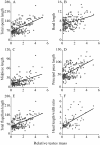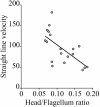Sperm competition and the evolution of sperm design in mammals
- PMID: 21232104
- PMCID: PMC3030547
- DOI: 10.1186/1471-2148-11-12
Sperm competition and the evolution of sperm design in mammals
Abstract
Background: The influence of sperm competition upon sperm size has been a controversial issue during the last 20 years which remains unresolved for mammals. The hypothesis that, when ejaculates compete with rival males, an increase in sperm size would make sperm more competitive because it would increase sperm swimming speed, has generated contradictory results from both theoretical and empirical studies. In addition, the debate has extended to which sperm components should increase in size: the midpiece to accommodate more mitochondria and produce more energy to fuel motility, or the principal piece to generate greater propulsion forces.
Results: In this study we examined the influence of sperm competition upon sperm design in mammals using a much larger data set (226 species) than in previous analyses, and we corrected for phylogenetic effects by using a more complete and resolved phylogeny, and more robust phylogenetic control methods. Our results show that, as sperm competition increases, all sperm components increase in an integrated manner and sperm heads become more elongated. The increase in sperm length was found to be associated with enhanced swimming velocity, an adaptive trait under sperm competition.
Conclusions: We conclude that sperm competition has played an important role in the evolution of sperm design in mammals, and discuss why previous studies have failed to detect it.
Figures



References
-
- Parker GA. Sperm competition and its evolutionary consequences in the insects. Biol Rev. 1970;45:525–567. doi: 10.1111/j.1469-185X.1970.tb01176.x. - DOI
-
- Birkhead TR, Møller AP. Sperm Competition and Sexual Selection. San Diego: Academic Press; 1998.
-
- Simmons LW. Sperm Competition and Its Evolutionary Consequences in the Insects. Princeton: Princeton University Press; 2001.
-
- Birkhead TR, Hosken DJ, Pitnick S. Sperm Biology. An Evolutionary Perspective. Burlington, MA: Academic Press; 2009.
Publication types
MeSH terms
LinkOut - more resources
Full Text Sources

